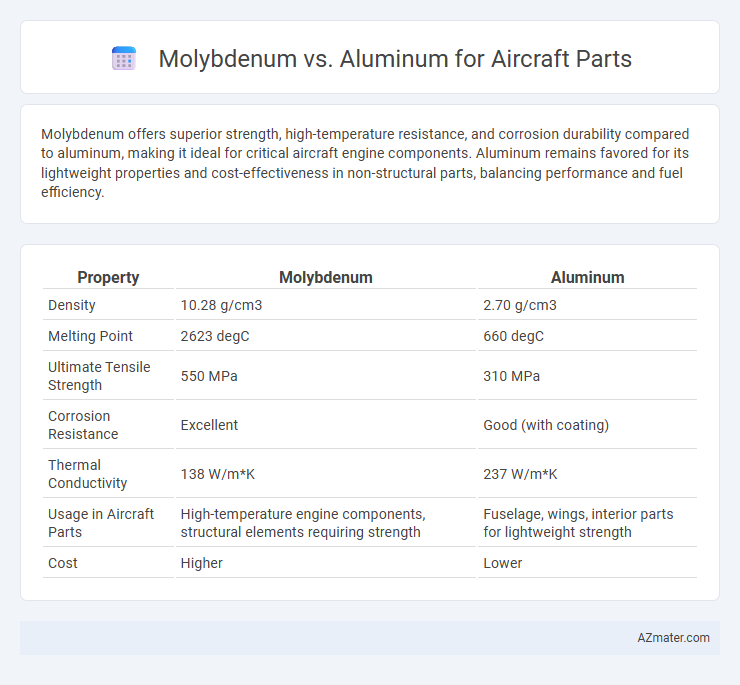Molybdenum offers superior strength, high-temperature resistance, and corrosion durability compared to aluminum, making it ideal for critical aircraft engine components. Aluminum remains favored for its lightweight properties and cost-effectiveness in non-structural parts, balancing performance and fuel efficiency.
Table of Comparison
| Property | Molybdenum | Aluminum |
|---|---|---|
| Density | 10.28 g/cm3 | 2.70 g/cm3 |
| Melting Point | 2623 degC | 660 degC |
| Ultimate Tensile Strength | 550 MPa | 310 MPa |
| Corrosion Resistance | Excellent | Good (with coating) |
| Thermal Conductivity | 138 W/m*K | 237 W/m*K |
| Usage in Aircraft Parts | High-temperature engine components, structural elements requiring strength | Fuselage, wings, interior parts for lightweight strength |
| Cost | Higher | Lower |
Introduction: Why Material Choice Matters in Aircraft Parts
Material choice in aircraft parts directly impacts performance, weight, and durability, with molybdenum offering superior strength and high-temperature resistance compared to aluminum. Molybdenum's high melting point of 2,623degC and excellent corrosion resistance enhance safety in critical engine components, while aluminum's lightweight nature and ease of fabrication contribute to overall fuel efficiency. Balancing these material properties is crucial for optimizing aircraft design, operational efficiency, and maintenance costs.
Molybdenum vs Aluminum: An Overview
Molybdenum offers superior strength and high-temperature resistance compared to aluminum, making it ideal for critical aircraft parts subjected to extreme conditions. Aluminum excels in lightweight applications due to its low density and corrosion resistance, enhancing fuel efficiency and durability in aerospace components. Choosing between molybdenum and aluminum depends on balancing weight requirements against mechanical strength and thermal stability in aircraft design.
Weight Comparison: Impact on Aircraft Performance
Molybdenum, with a density of approximately 10.28 g/cm3, is significantly heavier than aluminum, which has a density around 2.70 g/cm3, making aluminum a preferable choice for weight-sensitive aircraft components. The lower weight of aluminum reduces overall aircraft mass, enhancing fuel efficiency, payload capacity, and maneuverability, which are critical factors in aviation performance. Although molybdenum offers superior strength and high-temperature resistance, its greater weight can negatively impact aircraft range and fuel consumption when used in primary structural parts.
Strength and Durability Differences
Molybdenum offers superior tensile strength and high-temperature durability compared to aluminum, making it ideal for aircraft parts exposed to extreme stress and heat. Aluminum provides excellent strength-to-weight ratio and corrosion resistance but lacks the high-temperature performance and wear resistance of molybdenum. The choice between molybdenum and aluminum depends on specific aircraft part requirements, balancing weight savings with strength and long-term durability.
Corrosion Resistance: Which Metal Lasts Longer?
Molybdenum demonstrates superior corrosion resistance compared to aluminum, particularly in high-temperature and harsh environments commonly encountered in aerospace applications. While aluminum alloys offer lightweight benefits, they are more prone to oxidation and stress corrosion cracking, which can reduce the lifespan of aircraft parts. Molybdenum's robustness against oxidation and chemical attack ensures longer durability and reliability for critical aircraft components.
Thermal Conductivity and Heat Resistance
Molybdenum exhibits superior heat resistance with a melting point of 2,623degC compared to aluminum's 660degC, making it ideal for high-temperature aircraft components. While aluminum boasts a higher thermal conductivity around 205 W/m*K, facilitating efficient heat dissipation, molybdenum's lower thermal conductivity near 138 W/m*K provides stability under thermal stress. The enhanced heat resistance of molybdenum supports applications requiring durability in extreme environments, whereas aluminum's lightweight and thermal conductivity benefit heat management in less critical thermal zones.
Fabrication and Machinability Factors
Molybdenum offers superior high-temperature strength and corrosion resistance, making it ideal for aircraft parts exposed to extreme conditions, though its hardness can challenge machining processes and increase fabrication costs. Aluminum provides excellent machinability and lightweight properties, allowing for easier fabrication and reduced manufacturing time, but it lacks the heat resistance and strength of molybdenum under high-stress environments. Selecting between these metals depends on balancing the requirements for thermal stability, machinability, and overall weight in aircraft component design.
Cost Analysis: Molybdenum vs Aluminum
Molybdenum's higher raw material cost and machining expenses significantly exceed those of aluminum, impacting overall manufacturing budgets for aircraft parts. Aluminum offers excellent cost efficiency due to its abundance, lower density, and ease of fabrication, making it a preferred choice for lightweight structural components. While molybdenum provides superior strength and heat resistance, its economic feasibility is limited in large-scale applications where weight and cost optimization are critical.
Application Suitability in Aviation Industry
Molybdenum offers exceptional strength, high-temperature resistance, and corrosion durability, making it ideal for critical aircraft components exposed to extreme stress, such as engine parts and landing gear. Aluminum, valued for its lightweight and excellent machinability, is widely used in airframe structures, fuselage panels, and interior components to enhance fuel efficiency and overall aircraft performance. The choice between molybdenum and aluminum in aviation depends on balancing weight reduction with mechanical strength and thermal stability requirements specific to each aircraft part.
Conclusion: Choosing the Right Material for Aircraft Parts
Molybdenum offers exceptional strength, heat resistance, and durability, making it ideal for high-stress aircraft components like engine parts and fasteners. Aluminum provides lightweight properties and excellent corrosion resistance, reducing overall aircraft weight and enhancing fuel efficiency, especially suitable for airframes and fuselage structures. Selecting the right material hinges on balancing factors such as mechanical requirements, weight constraints, thermal tolerance, and cost-effectiveness to ensure optimal aircraft performance and safety.

Infographic: Molybdenum vs Aluminum for Aircraft Part
 azmater.com
azmater.com